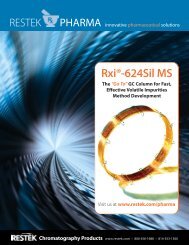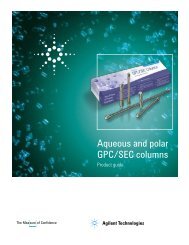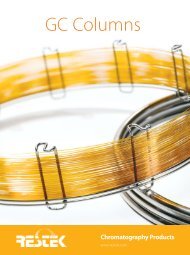Optimizing the Analysis of Volatile Organic Compounds
Optimizing the Analysis of Volatile Organic Compounds
Optimizing the Analysis of Volatile Organic Compounds
You also want an ePaper? Increase the reach of your titles
YUMPU automatically turns print PDFs into web optimized ePapers that Google loves.
Figure 29.<br />
Electromagnetic fields force <strong>the</strong> ions into a spiral, three-dimensional<br />
sine wave through <strong>the</strong> center <strong>of</strong> <strong>the</strong> quadrupole arrangement.<br />
-<br />
+<br />
+<br />
-<br />
Gamma Rays<br />
Signal<br />
AMU<br />
Offset<br />
Electron<br />
Nullifier<br />
Dynode<br />
Surface<br />
Ion Trap Operation<br />
The major difference between a quadrupole MS and an ion trap MS are <strong>the</strong> mechanisms <strong>of</strong><br />
ion focus and scanning. Three hyperbolic electrodes, a ring and two endcaps, form <strong>the</strong> core<br />
<strong>of</strong> an ion trap MS (Figure 30). In electron impact mode <strong>the</strong> sample is ionized, fragmented,<br />
and introduced into <strong>the</strong> ion trap through a pulsing electronic gate that opens and closes, controlling<br />
<strong>the</strong> number <strong>of</strong> ions that enter <strong>the</strong> trap. Ions that enter <strong>the</strong> trap are stored in stable<br />
orbits. Adjusting <strong>the</strong> voltage around <strong>the</strong> ring electrode pushes some <strong>of</strong> <strong>the</strong>se ions into unstable<br />
orbits, causing <strong>the</strong>m to exit to <strong>the</strong> detector. Because all ions entering <strong>the</strong> trap are stored<br />
temporarily, only a finite amount <strong>of</strong> sample can be allowed to enter <strong>the</strong> trap area, o<strong>the</strong>rwise<br />
<strong>the</strong> system would be overloaded.<br />
Interfacing <strong>the</strong> Capillary Column to <strong>the</strong> MS<br />
The ion source and analyzer <strong>of</strong> <strong>the</strong> MS are under vacuum. To enable <strong>the</strong> pumping system to<br />
maintain this vacuum, <strong>the</strong> volume <strong>of</strong> carrier gas entering <strong>the</strong> MS must be small. Regardless<br />
<strong>of</strong> <strong>the</strong> pumping capacity <strong>of</strong> <strong>the</strong> MS vacuum system, <strong>the</strong> best sensitivity is achieved if <strong>the</strong><br />
carrier gas flow rate is approximately 1mL/min. Because a narrow-bore capillary column<br />
routinely is operated at near 1mL/min. flow rates, it can be connected directly to <strong>the</strong> MS<br />
without overwhelming <strong>the</strong> pumping system. Wide-bore capillary columns, however, usually<br />
are operated at flow rates that are too high for most MS systems. Consequently, an interface<br />
must be used to reduce <strong>the</strong> flow to a level that is compatible with <strong>the</strong> MS pumping system.<br />
Figure 31 shows <strong>the</strong> two most common interfaces – <strong>the</strong> open split and <strong>the</strong> jet separator.<br />
An open split interface (OSI) functions like an inlet splitter system in a chromatograph. It<br />
allows as much as 90% <strong>of</strong> <strong>the</strong> carrier gas to be vented away from <strong>the</strong> MS vacuum system.<br />
Correspondingly, this is reflected by a sample loss <strong>of</strong> up to 90%, which reduces sensitivity<br />
by an order <strong>of</strong> magnitude. Therefore, an OSI is not suitable for trace-level environmental<br />
analysis. Splitting <strong>the</strong> sample at <strong>the</strong> injection port, combined with analysis on a narrow-bore<br />
column, is favored over using an OSI because a high desorb flow rate can be used to ensure<br />
better sample transfer from <strong>the</strong> trap. Also, a 0.25mm ID or narrower column increases efficiency<br />
and improves resolution <strong>of</strong> analytes.<br />
Ano<strong>the</strong>r alternative to an OSI, <strong>the</strong> jet separator, reduces <strong>the</strong> carrier gas flow without significant<br />
loss <strong>of</strong> sensitivity. A jet separator works on <strong>the</strong> principle <strong>of</strong> momentum. Very small<br />
molecules such as helium (or o<strong>the</strong>r carrier gas) do not have sufficient momentum to pass<br />
across a small gap in <strong>the</strong> jet separator and are routed away from <strong>the</strong> MS, using a vacuum<br />
pump. Larger molecules, such as most target components, have <strong>the</strong> necessary momentum to<br />
carry <strong>the</strong>m across <strong>the</strong> gap and into <strong>the</strong> MS. Using this device, much <strong>of</strong> <strong>the</strong> carrier gas can be<br />
eliminated without significant loss <strong>of</strong> target compounds. Added momentum is required to<br />
carry very small analyte molecules, such as gases, across <strong>the</strong> gap, however. In <strong>the</strong>se situations<br />
we recommend adding make-up gas to provide <strong>the</strong> extra momentum and improve<br />
responses for low molecular weight target compounds.<br />
Figure 30.<br />
Ring and end caps form <strong>the</strong><br />
core <strong>of</strong> an ion trap MS.<br />
31<br />
www.restekcorp.com











